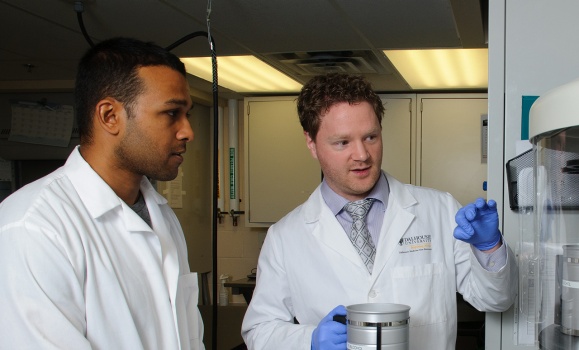» Go to news main
Making Breathing Easier for Heart Patients

Sherlock Holmes move over! A classic example of detective work to determine the cause of air-hunger in heart patients has been conducted by Dr. Keith Brunt, Assistant Professor Pharmacology, Dalhousie University and Dr. Jeremy Simpson, Associate Professor Human Health & Nutritional Studies, University of Guelph. Their findings, published in Science Translational Medicine today will fundamentally change textbooks on this disease process.
The mystery begins
This story begins in a bar over a glass of beer with two research colleagues discussing the finer points of terminology between congestive heart failure and heart failure. One points out that while most heart failure patients experience shortness of breath or air-hunger they don’t all have lung congestion. Thus the research question begins to form as to why? The two scientists are Dr. Keith Brunt and Dr. Jeremy Simpson.
This question led to a study on when is the first instance in which breathlessness could be identified in an experimental model. Their study took seven years and has now been published in Science Translational Medicine, a preeminent international medical journal.
The study examined what happens, when it happens, why it happens and what can treat it using an experimental model of hypertensive heart failure. The first two years of the study saw everything go well. However, what they initially expected to be a physical explanation for breathlessness was disproven by their own findings. “Confirmatory experiments failed and we had to figure out why. This led us to look at the brain,” explains Dr. Simpson.
They brought graduate students on board and co-supervised them at a distance between their two Universities as they established themselves as early career scientists in Canada.
Findings and what happens
“We’ve been treating heart failure and hypertension for 30 years but did not know about the role the kidney’s hormones have on the brain in creating breathlessness and what that would mean for heart patients,” explains Dr. Brunt. “We also didn’t realize the secondary effect of air-hunger actually occurs much sooner than the physical changes in the lungs.”
It begins with the kidneys sending signals to the brain as the heart develops trouble pumping enough blood. It requests more blood by sending out hormones (angiotensin and norepinephrine) to the brain which makes the heart pump harder and the respiratory muscles to work harder than they should. The problem occurs when the respiratory muscles don’t get a break. This leads to atrophy in the muscle tissue, which results in inefficient productivity that in turn would make patients breathless. The question became why some patients get better some of the time and others continue to struggle?
What helps and what this means for heart patients
Dr. Brunt and Dr. Simpson found that only a few drugs that are already on the market for heart failure (like candesartan) cross the blood-brain barrier and cancel out the signals to the brain. This enables the respiratory muscles to relax and recover. Other drugs (like valsartan) do not cross this barrier, so the signals continue and the patient experiences air-hunger.
“Basically these could findings could mean an improved quality of life for patients living with hypertension and developing heart failure,” states Dr. Simpson.
“The drugs we tested are already on the market, which means they can start being used today,” Dr. Brunt adds. “We don’t have to wait for the development and testing of new drugs that could take years or decades to help today’s patients – physicians can begin using this information in the art-of-medicine today.”
Looking forward
They are currently working with cardiologists and respirologists at the New Brunswick Heart Centre to monitor patients with hypertension and heart failure on these medications in a clinical study that focuses on the balance and combination of the medications prescribed. “It’s not just heart patients we are interested in, but we are also looking at how similar mechanisms may be operating in other diseases (like sleep apnea and COPD),” mentions Dr. Simpson.
This study was funded by the Heart and Stroke Foundation of Canada, the Canadian Lung Association and Natural Sciences and Engineering Research Council (NSERC).
Recent News
- Dalhousie’s first physician assistant cohort steps into Nova Scotia’s healthcare system
- Dalhousie med students explore pediatric care in Austria
- Dalhousie researchers shine at Discovery Awards with four top honours
- New $2M national study to uncover how biology, social factors shape MS outcomes
- Pathology EDIA Committee makes strides during 2024‑2025 year
- CCfV’s impact on vaccine innovation
- Unlocking the secrets of memory—with fruit flies
- Celebrating mobility research and the power of philanthropy
